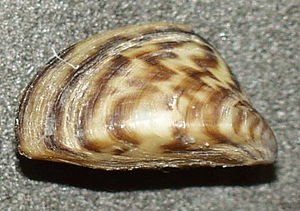 Image via Wikipedia
Image via Wikipedia
Uninfested waters underline the importance of
precautions against spreading the exotic invader.
JEFFERSON CITY–Hardly a week passes without an invasive plant or animal turning up in a new place. Consequently, the latest news about zebra mussels in Missouri reads a bit like “Man bites dog.”
Tim Banek, invasive species coordinator for the Missouri Department of Conservation (MDC), hears plenty of bad news about zebra mussels and other invasive species. But the lab report he received from 2011 zebra-mussel screenings of selected Missouri lakes and streams contradicts the perception that invasive species are everywhere.
Earlier this year, MDC Fisheries Division staff used fine mesh-sized plankton nets to collect samples and send them to a laboratory to be analyzed for the presence of zebra mussel larvae, known as veligers. Missouri waters sampled in 2011 included Smithville, Table Rock, Stockton, Norfork, Clearwater, Bull Shoals, Mark Twain, Pomme de Terre, Mozingo, Montrose, Hazel Creek, Forest, Thomas Hill, Blind Pony, Hunnewell, Springfield Hazel Hill, Maple Leaf, Binder, D.C. Rogers, Blue Springs, Longview, Little Dixie and Watkins Mill State Park lakes, and the Gasconade River. Banek was pleased but not surprised when every site got a clean bill of health. He said it is important for Missourians to know that most of their lakes and streams are free of zebra mussels.
“If people feel like zebra mussels are all over the place, they have no reason to take precautions to avoid spreading them,” he said. “They need to know where zebra mussels are, so the Conservation Department publishes those bad-news reports, but people need to know where zebra mussels aren’t, too.”
Each year, MDC checks for zebra mussels in high-risk lakes and streams and those that supply water for MDC fish hatcheries. We also tests less at-risk waters each year.
The only Missouri waters currently known to have zebra mussels are Lake of the Ozarks, Lake Taneycomo, upper Bull Shoals Lake, Lake Lotawana in Jackson County, the Missouri and Mississippi rivers, the lower Meramec River and the Osage River below Bagnell Dam.
According to Banek, knowing these lakes and streams have zebra mussels empowers Missourians to avoid spreading the invasive mussel. He said anglers and boaters have a lot to lose if zebra mussels and other exotic pests invade new areas. In the case of zebra mussels, possible costs include damage to boats, motors, docks and other marine equipment, not to mention the possible ecological consequences. A map of zebra mussel infested waters can be found at mdc.mo.gov/sites/default/
Banek urges Missourians to use information provided by MDC to hold the line on zebra mussels. He said they can start by doing three things before moving boats and equipment to a different lake or stream.
Clean – Remove all plants, animals and mud, and thoroughly wash everything, especially live wells, crevices and other hidden areas. Wash boat bilges, trailers, motor drive units and live wells with hot water at least 104 degrees. Most commercial car washes meet this standard.
Drain – Eliminate all water before leaving the area, including live wells, bilge and engine cooling water.
Dry – If boats and equipment can’t be thoroughly washed, allow them to dry in the sun for at least five days before launching in other waters.
Dispose – Anglers can also avoid spreading zebra mussels and other invasive pests by obtaining live bait locally and disposing of leftover bait properly.
“Even things as seemingly harmless as earthworms and crayfish can be trouble,” said Banek. “Some commercial bait comes from as far away as Canada. If you catch minnows in one place and take them somewhere else to fish, you could be transporting invasive Asian carp species without knowing it. Get your bait where you plan to fish, and put leftover bait in a trash container headed for the nearest landfill before leaving your fishing area. Never toss live bait into a lake or stream to feed the fish.”
For more information on zebra mussels and other invasive species, visitwww.missouriconservation.org.





No comments:
Post a Comment